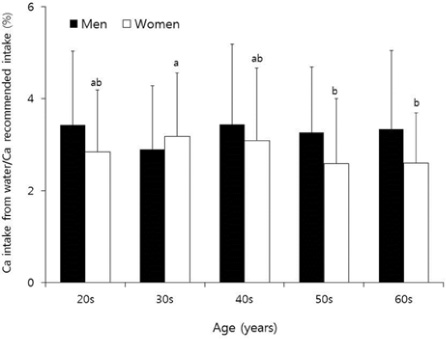Korean J Community Nutr.
2019 Feb;24(1):18-23. 10.5720/kjcn.2019.24.1.18.
Daily Water Consumption and its Contribution to Calcium Intake in Korean Adults
- Affiliations
-
- 1Division of Food Science, Kongju National University, Yesan, Korea, Student.
- 2Department of Food Science and Nutrition, Kyungpook National University, Daegu, Korea, Professor.
- 3Division of Food Science, Kongju National University, Yesan, Korea, Professor. mkchoi67@kongju.ac.kr
- KMID: 2439669
- DOI: http://doi.org/10.5720/kjcn.2019.24.1.18
Abstract
OBJECTIVES
Although water is essential for life and can supply essential minerals, studies that evaluate calcium intake through drinking water are limited. The aim of this study was to assess calcium contents of natural mineral water (NMW) and its possible contribution to calcium intake in healthy adults.
METHODS
This study examined water consumption in 640 Korean adults with selfselected diet, analyzed the calcium content of 10 different brands of bottled NMWs sold in Korea, and assessed the amount of calcium intake from drinking water and its daily contribution to the recommended nutrient intake (RNI) of calcium.
RESULTS
Mean calcium content in 10 bottled NMWs was 20.9 mg/l. Daily water intakes from food composition database and calculated using energy intake based on 0.53 ml/kcal were 957.2 ml and 1109.8 ml for men and 848.3 ml and 951.6 ml for women, respectively, with a significant difference by gender (p < 0.001). Daily drinking water intake was significantly higher among men than women (1203.9 ml vs. 1004.3 ml, respectively, p < 0.001). Daily calcium intakes from foods were 564.0 mg for men and 534.2 mg for women. Daily possible calcium intakes from drinking bottled water were 25.2 mg for men and 21.0 mg for women (p < 0.001). The contribution of daily calcium intake from drinking bottled water to RNI of calcium was 3.3% for men and 2.9% for women without significant difference.
CONCLUSIONS
One half of the daily total water intake was consumed as drinking water, and possible calcium intake through drinking water was about 3% of RNI.
MeSH Terms
Figure
Reference
-
1. Daniels MC, Popkin BM. Impact of water intake on energy intake and weight status: a systematic review. Nutr Rev. 2010; 68(9):505–521.
Article2. Popkin BM, D'Anci KE, Rosenberg IH. Water, hydration, and health. Nutr Rev. 2010; 68(8):439–458.
Article3. Ministry of Health and Welfare. Dietary reference intakes for Koreans 2015. Sejong: Ministry of Health and Welfare;2015. p. 212–238.4. Jéquier E, Constant F. Water as an essential nutrient: the physiological basis of hydration. Eur J Clin Nutr. 2010; 64(2):115–123.
Article5. Cidu R, Frau F, Tore P. Drinking water quality: comparing inorganic components in bottled water and Italian tap water. J Food Compos Anal. 2011; 24(2):184–193.
Article6. Whelton AJ, Dietrich AM, Burlingame GA, Schechs M, Duncan SE. Minerals in drinking water: impacts on taste and importance to consumer health. Water Sci Technol. 2007; 55(5):283–291.
Article7. Lee SJ, Lee SG, Kim JG, Park HK. Assessment of Korean spring waters using a new mineral water index. J Korean Soc Water Wastewater. 2011; 25(1):7–14.8. Schroeder HA. Relation between mortality from cardiovascular diseases and treated water supplies. J Am Med Assoc. 1960; 172(17):1902–1908.9. Garzon P, Eisenberg MJ. Variation in the mineral content of commercially available bottled waters: Implications for health and disease. Am J Med. 1998; 105(2):125–130.
Article10. Weinheimer EM, Martin BR, Weaver CM, Welch JM, Campbell WW. The effect of exercise on water balance in premenopausal physically active women. J Am Diet Assoc. 2008; 108(10):1662–1667.
Article11. Korea Centers for Disease Control and Prevention. 2015 Korea Health Statistics. Sejong: Ministry of Health and Welfare of Korea;2016.12. Kim YS. The determinants of tap water consumption patterns. J Korean Home Manag Assoc. 2006; 24(2):93–106.13. Levallois P, Grondin J, Gingras S. Evaluation of consumer attitudes on taste and tap water alternatives in Quebec. Water Sci Technol. 1999; 40(6):135–139.14. Doria MF. Bottled water versus tap water: understanding consumer' preferences. J Water Health. 2006; 4(2):271–276.15. Teillet E, Urbano C, Cordelle S, Schlich P. Consumer perception and preference of bottled and tap water. J Sens Stud. 2010; 25(3):463–480.
Article16. World Health Organization. Guidelines for drinking water quality. 4th ed. Geneva: World Health Organization;2011. p. 164.17. Moreno L, Merlos A, Abramova N, Jiménez C, Bratov A. Multi-sensor array used as an “electronic tongue” for mineral water analysis. Sens Actuators B: Chem. 2006; 116(1-2):130–134.
Article
- Full Text Links
- Actions
-
Cited
- CITED
-
- Close
- Share
- Similar articles
-
- Effect of Pre-meal Water Consumption on Energy Intake and Satiety in Non-obese Young Adults
- A Study on Fluid Intake and Output Measurements
- The Association between Coffee Consumption and Bone Status in Young Adult Males according to Calcium Intake Level
- The Relationship between Daily Calcium Intake and Plasma Homocysteine Concentrations in Adults
- Ready-to-eat Cereal Consumption Enhances Milk and Calcium Intake in Korean Population from 2001 Korean National Health and Nutrition Survey



